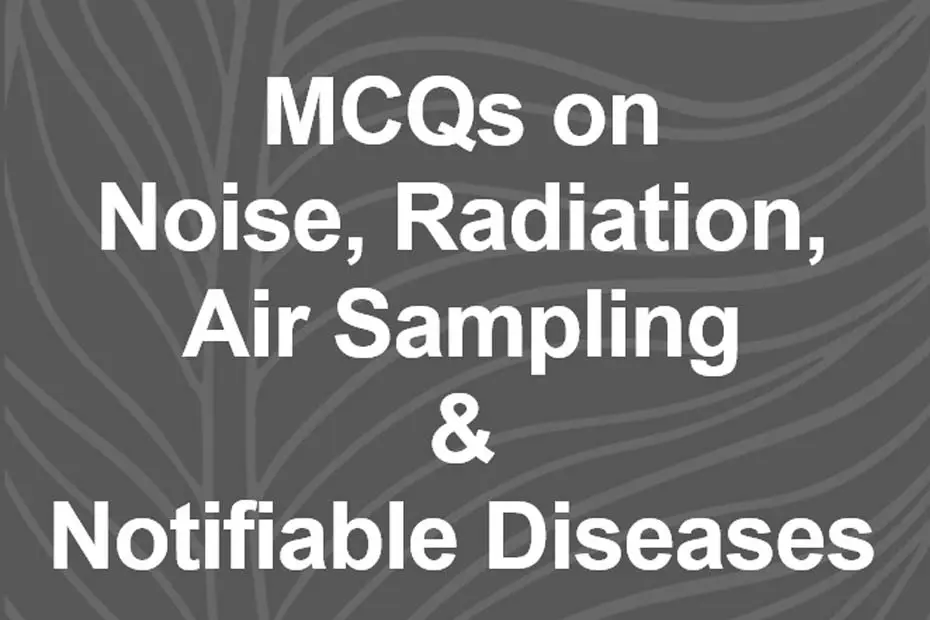1. What is the primary cause of Noise-Induced Hearing Loss (NIHL)?
a) Bacterial infections
b) Aging
c) Prolonged exposure to loud noises
d) Genetics
Answer: c) Prolonged exposure to loud noises
2. Which part of the ear is most vulnerable to damage from excessive noise exposure?
a) Cochlea
b) Eardrum
c) Ear canal
d) Auditory nerve
Answer : a) Cochlea
3. What is the threshold level of noise exposure that is considered harmful for hearing?
a) 70 decibels
b) 85 decibels
c) 100 decibels
d) 120 decibels
Answer : b) 85 decibels
4. Which of the following activities is most likely to lead to NIHL?
a) Listening to music at a moderate volume
b) Attending a rock concert without hearing protection
c) Reading a book in a quiet room
d) Taking a leisurely walk in a park
Answer : b) Attending a rock concert without hearing protection
5. What is a common symptom of Noise-Induced Hearing Loss?
a) Dizziness
b) Tinnitus (ringing in the ears)
c) Blurred vision
d) Loss of taste
Answer : b) Tinnitus (ringing in the ears)
6. How can NIHL be prevented?
a) Using earplugs or earmuffs in noisy environments
b) Consuming vitamin supplements
c) Avoiding all loud noises completely
d) Wearing sunglasses
Answer : a) Using earplugs or earmuffs in noisy environments
7. Which of the following professions is at a higher risk of developing NIHL?
a) Librarian
b) Construction worker
c) Chef
d) Graphic designer
Answer : b) Construction worker
8. What is the term for the temporary hearing loss or ringing in the ears experienced after exposure to loud noise?
a) Tinnitus
b) Hyperacusis
c) Auditory fatigue
d) Temporary threshold shift (TTS)
Answer : d) Temporary threshold shift (TTS)
9. Which of the following types of radiation is NOT ionizing?
a) X-rays
b) Ultraviolet (UV) radiation
c) Gamma rays
d) Radio waves
Answer : d) Radio waves
10. What is the unit of measurement for radiation exposure?
a) Ampere (A)
b) Coulomb (C)
c) Gray (Gy)
d) Newton (N)
Answer : c) Gray (Gy)
11. What is the main source of background radiation that humans are exposed to daily?
a) Cosmic rays
b) Microwave radiation
c) Radioactive household items
d) Infrared radiation
Answer : a) Cosmic rays
12. Which type of radiation is commonly used in medical imaging, such as X-rays?
a) Alpha radiation
b) Beta radiation
c) Gamma radiation
d) Neutron radiation
Answer : c) Gamma radiation
13. What is the process by which an unstable atomic nucleus emits radiation to become more stable?
a) Nuclear fusion
b) Nuclear fission
c) Radioactive decay
d) Ionization
Answer : c) Radioactive decay
14. Which of the following materials is commonly used as shielding against ionizing radiation?
a) Lead
b) Aluminum
c) Plastic
d) Glass
Answer : a) Lead
15. What is the term for the smallest quantity of a radioactive substance that will produce a detectable effect?
a) Radioactive decay
b) Critical mass
c) Half-life
d) Becquerel
Answer : b) Critical mass
16. Which form of radiation is associated with cell phone and microwave communication?
a) Infrared radiation
b) Radio waves
c) Gamma rays
d) Ultraviolet (UV) radiation
Answer : b) Radio waves
17.What is the primary purpose of air sampling?
a) To measure wind speed
b) To collect and analyze airborne contaminants
c) To monitor temperature and humidity
d) To assess soil pollution
Answer : b) To collect and analyze airborne contaminants
18. Which of the following sampling methods is used to collect particulate matter suspended in the air?
a) Gravimetric sampling
b) Soil sampling
c) Water sampling
d) Noise sampling
Answer : a) Gravimetric sampling
19. Which device is commonly used for collecting gaseous air pollutants in ambient air?
a) Wind vane
b) Barometer
c) Gas chromatograph
d) Anemometer
Answer : c) Gas chromatograph
20. What is the purpose of a high-volume air sampler?
a) To measure wind speed at high altitudes
b) To sample large volumes of air for contaminants
c) To monitor ozone depletion
d) To measure radiation levels in the atmosphere
Answer : b) To sample large volumes of air for contaminants
21. Which air sampling technique involves the collection of air using a pump and filter for subsequent laboratory analysis?
a) Passive sampling
b) Active sampling
c) Remote sensing
d) Spectroscopy
Answer : b) Active sampling
22. In indoor air quality assessment, which parameter is often monitored to detect the presence of volatile organic compounds (VOCs)?
a) Carbon dioxide (CO2)
b) Nitrogen dioxide (NO2)
c) Ozone (O3)
d) Total volatile organic compounds (TVOC)
Answer : d) Total volatile organic compounds (TVOC)
23. What is the purpose of a sorbent tube in air sampling?
a) To measure wind speed
b) To trap and concentrate specific gases or vapors
c) To measure humidity levels
d) To collect dust particles
Answer : b) To trap and concentrate specific gases or vapors
24. Which type of air sampling is commonly used for assessing workplace exposure to hazardous substances?
a) Ambient air sampling
b) Personal air sampling
c) Residential air sampling
d) Environmental air sampling
Answer : b) Personal air sampling
25. Which of the following is NOT considered a work-related disease?
a) Carpal tunnel syndrome
b) Influenza
c) Asbestosis
d) Noise-induced hearing loss
Answer : b) Influenza
26. What term describes a disease caused by long-term exposure to harmful substances or conditions in the workplace?
a) Occupational illness
b) Acute disease
c) Chronic infection
d) Genetic disorder
Answer : a) Occupational illness
27. Which industry is most commonly associated with occupational exposure to asbestos?
a) Information technology
b) Construction and insulation
c) Agriculture
d) Retail
Answer : b) Construction and insulation
28. What is the primary method for preventing work-related diseases?
a) Mandatory vaccination
b) Personal protective equipment (PPE)
c) Workplace hygiene and safety measures
d) Regular health check-ups
Answer : c) Workplace hygiene and safety measures
29. Which work-related disease is characterized by inflammation and scarring of the lung tissue due to the inhalation of crystalline silica dust?
a) Silicosis
b) Mesothelioma
c) Dermatitis
d) Pneumonia
Answer : a) Silicosis
30. Which type of work is most commonly associated with the risk of developing carpal tunnel syndrome?
a) Heavy lifting
b) Frequent keyboard use
c) Outdoor construction
d) Welding
Answer : b) Frequent keyboard use
31. What is the term for a condition where there is a loss of muscle and coordination control due to repetitive and forceful movements at work?
a) Osteoarthritis
b) Repetitive strain injury (RSI)
c) Hypertension
d) Tuberculosis
Answer : b) Repetitive strain injury (RSI)
32. Which infectious disease is a significant concern in healthcare settings due to the risk of transmission from patient to healthcare worker?
a) Common cold
b) Malaria
c) Tuberculosis
d) Food poisoning
Answer : c) Tuberculosis
33. What is a notifiable disease?
a) A disease that is extremely rare
b) A disease that must be reported to public health authorities by law
c) A disease that is only transmitted through animals
d) A disease that is not contagious
Answer : b) A disease that must be reported to public health authorities by law
34. Who is typically responsible for reporting notifiable diseases to public health authorities?
a) Healthcare providers
b) Patients
c) Schools
d) Employers
Answer : a) Healthcare providers
35. Which of the following diseases is often considered notifiable in most countries?
a) Common cold
b) Chickenpox
c) Seasonal allergies
d) Acne
Answer : b) Chickenpox
36. Why are notifiable diseases important to public health?
a) They are always fatal and need immediate attention.
b) They can spread quickly and pose a significant public health threat.
c) They are rare and require special research.
d) They have no impact on public health.
Answer : b) They can spread quickly and pose a significant public health threat.
37. Which agency or organization is often responsible for maintaining a list of notifiable diseases?
a) World Health Organization (WHO)
b) Centers for Disease Control and Prevention (CDC)
c) International Red Cross
d) United Nations Children’s Fund (UNICEF)
Answer : b) Centers for Disease Control and Prevention (CDC)
38. How does the reporting of notifiable diseases benefit public health efforts?
a) It helps identify emerging health trends and patterns.
b) It ensures that all diseases are treated equally.
c) It leads to the immediate quarantine of affected individuals.
d) It provides financial assistance to affected individuals.
Answer : a) It helps identify emerging health trends and patterns.
39.In the context of notifiable diseases, what does “surveillance” refer to?
a) The process of providing vaccines
b) The ongoing monitoring and collection of disease-related data
c) The treatment of infected individuals
d) The isolation of affected individuals
Answer : b) The ongoing monitoring and collection of disease-related data.
40.Silicosis is a respiratory disease primarily caused by the inhalation of:
a) Asbestos fibers
b) Tobacco smoke
c) Silica dust
d) Radon gas
Answer : c) Silica dust
41.Which industry or occupation is most commonly associated with the risk of developing silicosis?
a) Textile manufacturing
b) Coal mining
c) Hairdressing
d) Food service
Answer : b) Coal mining
42. Asbestosis is caused by the inhalation of asbestos fibers, which can lead to scarring of the:
a) Liver
b) Lungs
c) Heart
d) Kidneys
Answer : b) Lungs
43. Pneumoconiosis is a term that refers to:
a) Inflammation of the skin
b) Lung diseases caused by the inhalation of mineral dust
c) Infections of the urinary tract
d) Neurological disorders
Answer : b) Lung diseases caused by the inhalation of mineral dust
44. Which of the following diseases is a type of pneumoconiosis often associated with coal miners?
a) Silicosis
b) Asbestosis
c) Byssinosis
d) Black lung disease
Answer : d) Black lung disease
45. What is the primary way to prevent silicosis, asbestosis, and other pneumoconioses?
a) Wearing ear protection
b) Regular exercise
c) Using appropriate respiratory protection and dust control measures
d) Increasing vitamin intake
Answer : c) Using appropriate respiratory protection and dust control measures
46. Which of these diseases is characterized by the buildup of fibrous scar tissue in the lungs, reducing their elasticity and impairing breathing?
a) Silicosis
b) Asbestosis
c) Pneumoconiosis
d) Mesothelioma
Answer : b) Asbestosis
47. Which mineral is the primary cause of asbestosis when its fibers are inhaled?
a) Silica
b) Asbestos
c) Lead
d) Radon
Answer : b) Asbestos
48. What is the science that studies the poisonous or toxic properties of substances?
a) Virology
b) Toxicology
c) Epidemiology
d) Pharmacology
Answer: b) Toxicology
49. TLV’s and PEL’s are published by which of the following agencies?
a) NIOSH & OSHA
b) ACGIH & MSHA
c) ACGIH & OSHA
d) OSHA & MSHA
Answer: c) ACGIH & OSHA
50. Symptoms of this condition are fatigue, weakness, blurred vision, dizziness & Headache?
a) Heat Stress
b) Dehydration
c) Heat Exhaustion
d) Heat Stroke
Answer: c) Heat Exhaustion




